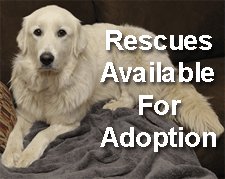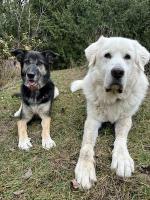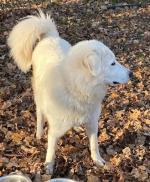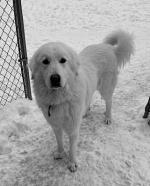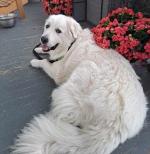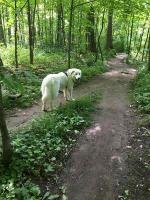Daisy and Angel (Bonded Pair)

*ADOPTED *
AN UPDATE FROM THEIR NEW FAMILY
We have had a great week here, started training off leash and learning to respect the front yard as a danger zone, and it is going really well. The girls are curious around the pond (there are lots of sounds and smells). Daisy comes really well when called if they get away a little, we just have to be patient with Angel, but she comes. This morning they were acting a little funny in the house, so I took them out back, and they walked with me, then ran to the field, when I caught up to them they were both pooping in the field!!! Good girls!!! stuff I don't have to pick up :) they both came running back to me and we walked for another 20 minutes together.
They are just the sweetest. We have introduced them to friends, young children and they have reacted way better than expected. We just feel they are going to be a great fit for our family and the attention we get back to us is 10x more.
Enjoy this little clip from yesterday https://photos.app.goo.gl/3SvqeNME4W8DBAkA8 ... Angel was still a little hesitant being off leash, but Daisy was a darling. Oh.. and yes they love to come to the barn, engage with the chickens... and help feed the goats and pigs. and they LOVE to crack and egg and eat it shell and all.
*UPDATE FROM THEIR FOSTERS*
We have had Daisy and Angel for about a month now. They are the two most loving, well-behaved dogs We have ever fostered.
If you are looking for a Pyrenees experience, these are not for you. They are more Labrador then Pyr – if any Pyr at all.
They are easy, clean, smart and always looking for love.
From the first day we’ve had them,they have been off leash on our property. It’s been no problem, they run around, play and come when called.
They sleep together in a large kennel at night and are quiet as mice. All you hear in the morning is their happy tails banging in anticipation of seeing you.
I don’t think I’d would separate them. They are very bonded. They always sit, sleep, and seek with each other.
My biggest issue, if you’d call it that, is that they know no boundaries. Especially Angel. They will cuddle next to our other two dogs. They always want to be beside you and be petted and will even push your hands for that. We’ve been working with them to be only petted when they are calm.
They have absolutely no food issues, and are not counter surfers. They do play during their walks with growls and nipping at each other.
They are great with my senior cat and my cat feels safe around them.
They’ve met a few dogs from around here and they seem to get along, again boundaries. If they are too much–in their face–the other dogs have let them know, and they backed off.
We do not have many small children around, but they are great with our neighbours children, 8 and 10.
*ON ARRRIVAL TO OUR CARE*
Daisy and Angel appear to be mother/daughter. They are extremely sweet and laid back, good in their crates, not happy about doing their business on leash since they've spent most time loose to to their business.
They don't react to other dogs. We think they'd be fine with cats.
They are Lab/Bernard/Pyr cross we think. They are more like labs.
Daisy is somewhat overweight so she would love to get out out walking and hiking with her new family. She is eight years old.
Children over 12 years old due to her size.
Her new home must have at least 5 foot high secure fencing.
Make sure to do your research on any breed in which you are interested. Please read the following about the Pyr:
They are lovely but not a breed for most people. They are great dogs when they come from ethical/reputable breeders, with the crucial socialization and handling by many many different people. They were developed by man to be working dogs. Here is a brief summary of the Pyr:
They are beautiful dogs with great temperaments given the right breeding, socialization, care including diet and training. Dogs are a lifelong commitment.
BARKING: They bark more than most dogs and neighbours do complain. That is a common reason for people surrendering their Pyrs (they didn’t do their research). Their bark is what deters predators and it is instinct to them. That and marking their territory. To take away their bark is to take away who they are. The barking can be managed but it takes time, patience and consistency with positive-reinforcement training. If you don’t like barking, they are not the dog for you.
CONTAINMENT: Pyrs love to hang out outside and their instinct is to wander. Therefore, they require at least a 5-foot secure fence in a large yard in which they can play, run and watch over. Some have been know to scale any height of fencing. No tie outs for these guys. It can lead to aggression since they cannot fully watch over their territory. If they are out all day, as they usually prefer, they need shelter from the elements. And, no electric collars or invisible fencing. If you do not want to fence, this is not the dog for you.
DIGGING: They dig holes in your garden to stay cool in summer so you’ll want to set aside some garden for them.
DIET: Raw is the species-appropriate diet. They eat 2%-3% of the ideal body weight. The breakdown is about 50% edible bone, 35% muscle meat and 5-10% organ meat of beef, chicken, rabbit, deer etc. Do not feed what they are guarding. Start them out on one protein until they are used to it and gradually add another. If you need to feed kibble, ensure it is of high quality and preferably the baked kind. Here is an excellent resource: Raw Roundup.
DOGS: If you want more than one dog in the home or working, we always recommend two dogs of the opposite sex. Two males or two females do not always see eye-to-eye and fights will ensue in most cases, but not all.
EXERCISE: They require regular walks, of course, so they get out and see the world to keep them interested in life. They must be leashed because they will wander. Again, they have been specifically bred to wander with sheep as they watch over them. It’s suggested to use a front lead harness which will cut down on any damage to the spine should the dog pull although, with a little training, they will be good on a leash. If you don't want to get out there and hike/walk your dog, this is not the dog for you.
GROOMING: Working and companion dogs must be groomed. They require a good weekly grooming to keep them mat free and their skin healthy (hence, pain free from the pulling of mats as they move), and cutting their nails including their dew claws every couple of weeks to a month. NEVER have their dew claws removed. This is a barbaric practice. Simply keep the dews trimmed.
They molt twice a year and shed all year round so your vacuum stays full. NEVER shave a Pyr. Their coats keep them cool in summer–they lose their undercoat, leaving just guard hairs–the guard hairs protect your dog from sunburn and insulate him against heat, as well as allowing air to circulate to keep the skin cool–and warm in winter–their undercoat grows close to the skin to keep your dog warm and dry. This system only works if you groom your dog regularly. If you don’t like grooming, take your dog to a master groomer. If you don’t want to groom your dog, this isn’t the dog for you.
TRAINING: They require a lot of socialization as pups onward with people and other dogs. They also require positive-reinforcement training (a trainer who shows you how to work with a clicker). Pyrs, nor any dogs, take kindly to any kind of punishment. Always use positive-reinforcement training. It will lead to aggression. Dr. Sophia Yin and Susan Garrett are great website resources.
It’s important to work with dogs as if in a dance and you are leading. Rewards for good behaviour and redirect for unwanted behaviour. It’s up to you to make them a good canine citizen. When engaging a trainer, ensure they use positive-reinforcement training to show you how to manage your dog. Never send a dog away for training. You are the one working with the dog, not a trainer. If you are not ready to train a dog, this is not the dog for you.
To train a Pyr is not like training some other breeds. They are not eager-to-please and just as soon walk away from you than do as you say. They were bred by man to be used as guardian livestock dogs because they do not require human intervention to tell them how to do their job. Lots of patience, consistency and time is required to work with them. If you want an obedient dog, this is not the dog for you.
TRAINING FOR LIVESTOCK: There are a few who just want to be a companion dog. Most are natural guardian dogs of livestock. Yes, it is instinct. However, you must introduce your dog to any livestock slowly. This means leashing your dog to you as you work about the animals and barns so they get used to them. When you are not there, keep them safely away from the animals yet still in sight of them. Fowl can be difficult for dogs because of how they move but it can be done. It will take at least a month for a Pyr to get used to the animals, maybe less. You’ll know when they are ready, and the dog will take it from there.
Return to Post A Happy Tail 2018.
Breaking News
-
Courtesy - Bear
Apr 09, 25 09:09 AM
Bear DOB: October 2018 Location: Midland, Ontario Pyr/Maremma? mix Single family home with a large securely-fenced property or a hobby farm. Purchased/adopted -
Courtesy Post - Willow
Apr 09, 25 09:07 AM
DOB: March 26th, 2022 Location: London Ontario Cross Pyr/Collie Obtained her privately through a friend. How long have you had her? 10 months Spayed -
Lucy
Apr 09, 25 09:06 AM
*Foster-to-Adopt* or *Foster* DOB: January 3, 2024 Location: Acton, Ontario She will need a single-family home with a securely fenced yard of at least -
Remi
Apr 09, 25 07:44 AM
Location: Acton, Ontario DOB: February 2024 This sweet white fluffy Remi has a sad story. Remi, while his family was in the midst of moving, escaped and -
Grieving Dog
Apr 04, 25 06:17 PM
Background: I am seeking some feedback if anyone has had experience with bonded pairs. Thank you! We have been fortunate to love 2 x almost 10 year -
Leo
Mar 12, 25 06:32 AM
*ADOPTED* DOB: September 2023 (almost 1.5-years-old) Location: Acton, ON Single family home with a securely fenced yard required. This sweetheart was -
Buster
Mar 10, 25 03:36 PM
*Buster is going back to his original family as things have brightened up in their lives and he'll have a wonderful life on acreage.* Buster had to come -
Courtesy - Maya
Jan 08, 25 05:35 PM
*ADOPTED* Location: Dunnville, ON DOB: Jan. 3, 2021 (3.5 years) Spayed Companion Dog, Pyr mix Good with children. Single family home. Raw diet (species-appropriate)










